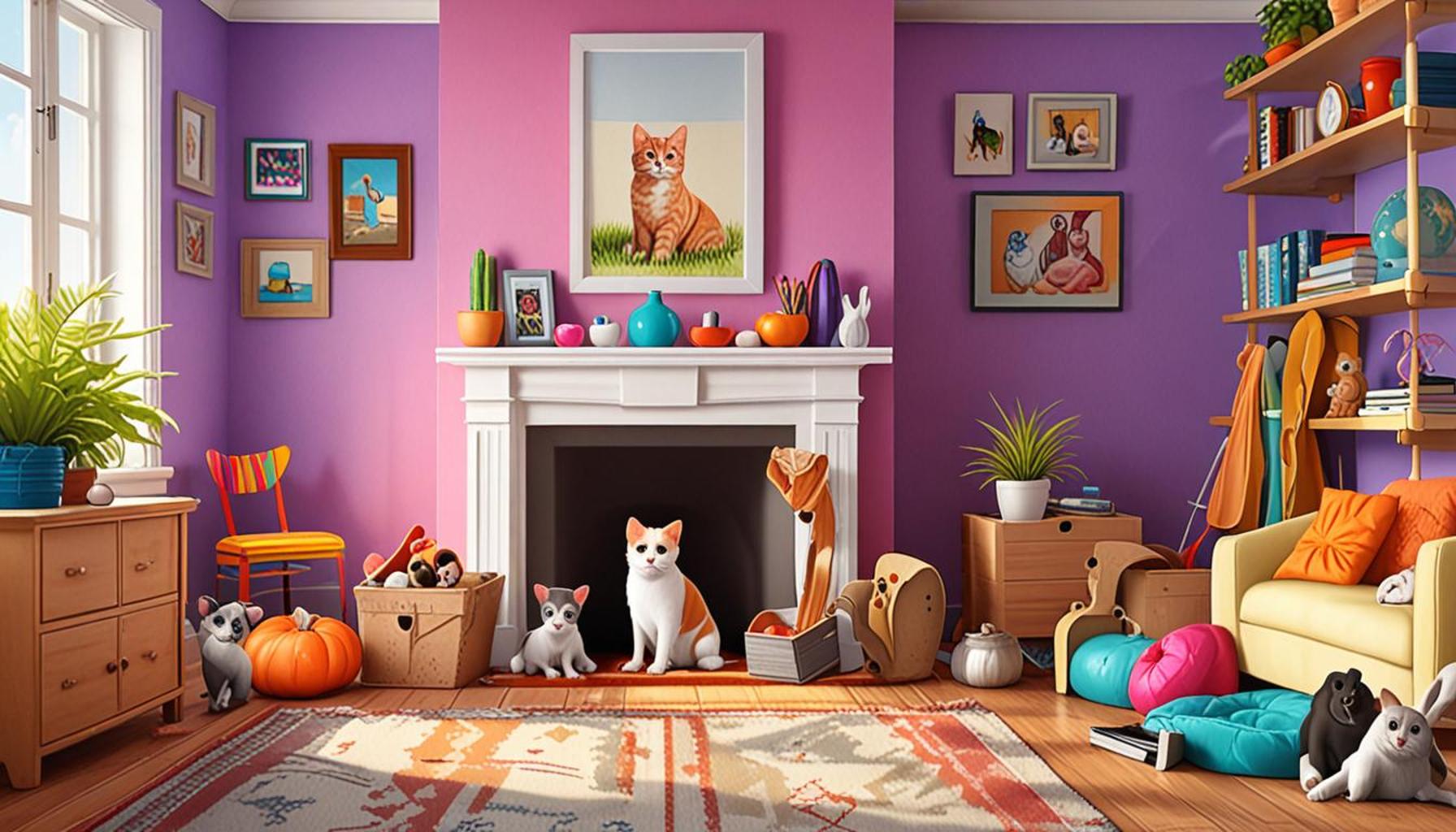How to Prepare Your Home for the Arrival of a New Pet: Tips Before Adoption

Preparing Your Home for a New Pet
Welcoming a new furry friend into your household is an experience that offers a unique blend of joy and responsibility. Beyond the excitement of cuddles and companionship, it’s essential to consider the logistical aspect of integrating a pet into your life. Preparing your space with thoughtfulness can establish a nurturing environment that benefits both you and your new companion.
Assess Your Space
Before your pet arrives, it’s important to evaluate your living environment. Identify practical locations for their bed, food, and play areas to ensure they feel secure and comfortable. For example, consider placing the food and water bowls in a quiet corner of the kitchen. If you have a dog, a designated area in the living room can serve as a play zone, while a quiet corner can function as their sleeping area. Cats might appreciate a secluded spot where they can observe their surroundings undisturbed.
Pet-Proof Your Home
Creating a safe environment is paramount. Begin this process by eliminating any hazards that could pose risks to your new pet. For instance, check for toxic houseplants like lilies or philodendrons; these can be harmful if ingested. Additionally, secure loose wires or small items that a curious pet might swallow, such as coins or buttons. If you have stairs, consider installing gates to prevent accidental falls, especially if you’re introducing a puppy or a kitten who may still be learning to navigate their new space.
Gather Supplies
Equipping yourself with the right supplies is a key part of preparation. Essential items include high-quality food tailored to your pet’s specific needs, fresh water bowls, and litter boxes, if you’re adopting a cat. Don’t overlook the importance of toys; they not only provide entertainment but also stimulate your pet’s mind. Opt for chew toys for dogs and scratching posts for cats to help keep them engaged and reduce behavioral issues.
Create a Safe Zone
Designating a safe zone for your new companion is vital to help them acclimate to their new surroundings. This area should feature their bed, toys, and food and water supplies and be free from loud noises and foot traffic. This retreat can be particularly comforting during the initial adjustment period, allowing your pet to explore their new world at their own pace. As they become more comfortable, they will likely venture into other parts of the home.

Understanding your responsibilities before bringing a new pet into your home can significantly ease the transition process. It empowers you to create an environment that not only prioritizes safety but also fosters a loving atmosphere for your new friend. In the forthcoming sections, we will explore each of these tips in depth, equipping you with the knowledge you need to embark on this fulfilling journey together.
DISCOVER MORE: Click here to learn about the benefits of socialization training
Creating the Ideal Environment
As you prepare for the arrival of your new pet, it’s not just about bringing home food and toys. Setting the stage for their transition into your life involves a deep understanding of what creates a comfortable and welcoming environment. Your home should reflect a space where your new companion can thrive both physically and emotionally.
Evaluate Your Family Dynamics
Understanding how your new pet will fit into your family dynamics is crucial. Every household has its own rhythm, and it’s important to consider factors like children, existing pets, and even roommates. For families with young children, introducing the pet gently can help to avoid overwhelming them. Supervise interactions initially, and teach children how to approach and interact with the new addition respectfully. When integrating with existing pets, a gradual introduction is recommended to minimize stress and territorial behavior.
Consider the Size and Temperament of Your New Pet
The size and temperament of the pet you choose can also affect your home’s setup. Smaller breeds or cats often require less space and can adapt to more confined areas. For example, adopting a small dog might mean they are content resting in a cozy corner or snuggled on your couch. On the other hand, larger breeds may require more space to roam and play, making it essential to create a designated area where they can exercise.
Research Pet-Specific Needs
Different pets come with different requirements, and satisfying these needs is paramount for their well-being. Here are some essential supplies you may consider for various types of pets:
- Dogs: Leashes, harnesses, high-quality dog food, and grooming supplies.
- Cats: Litter boxes, scratching posts, and cat trees.
- Birds: Cages, toys, and perches designed for their size.
- Small mammals: Habitat enclosures, bedding materials, and chew toys.
The key is to tailor your preparations to fit the unique needs of your new pet. For example, while cats generally require minimal grooming, some breeds may need regular brushing to maintain their coat. Similarly, certain dog breeds might have specific dietary needs or exercise requirements. Acquainting yourself with these aspects helps you provide a focused and loving environment that caters to your pet’s individual needs.
Budget for Ongoing Expenses
Finally, consider the ongoing financial responsibilities that come with pet ownership. From food and grooming to veterinary care and pet insurance, managing these costs can significantly affect your lifestyle. Establish a budget before bringing your new pet home to ensure that you can provide them with everything they need, while also reserving funds for unexpected health issues or emergencies. A well-planned budget helps alleviate the stress associated with unexpected pet care expenses.
As you embark on this journey of welcoming a new furry friend into your life, taking these steps to prepare your home will enable a smoother transition. With careful planning, you will create an environment that ensures your new companion feels loved, safe, and secure.
| Preparation Step | Details |
|---|---|
| Create a Safe Space | Designate an area where your new pet can feel secure, complete with a cozy bed and necessary supplies. |
| Pet-Proofing Your Home | Remove hazards such as toxic plants, small objects, and secure electrical cords to prevent accidents. |
| Buy Essential Supplies | Invest in food, water bowls, toys, a leash, and a pet carrier to ensure you’re fully prepared for the transition. |
| Consult Your Veterinarian | Schedule a health check-up for vaccinations and advice on pet care tailored to your specific type of pet. |
In preparing your home for the arrival of a new pet, establishing a routine becomes essential. Pets thrive on consistency. Implement feeding times, walks, and playtime, making sure to adjust your household schedule accordingly. This will help in building a bond between you and your new companion while also providing ample opportunities for socialization.Another crucial aspect is integrating your new pet with existing pets. Gradually introduce them to each other, starting from a distance and monitoring their reactions. Utilize calming products or pheromone diffusers to ease the transition and reduce anxiety for both parties.Finally, research breed-specific characteristics and needs. Understanding them better enables you to tailor your home environment for their physical and psychological well-being. The journey toward becoming an exemplary pet owner starts here, with informed and thoughtful preparation.
DON’T MISS: Click here to learn essential tips!
Making Your Home Safe and Secure
When preparing to welcome a new pet into your home, one of the most critical tasks is ensuring your living space is safe and secure. Pets, especially in their early days with you, are curious explorers, and taking steps to pet-proof your home can help prevent accidents and injuries. Understanding potential hazards can significantly reduce risks associated with their curiosity and playful antics.
Identify Pet Hazards
Begin by walking through your home and considering what might pose a threat to your new companion. Common hazards include:
- Cords and Wires: Electrical cords can be particularly tempting for pets to chew on. Use cord protectors or rearrange furniture to keep these out of reach.
- Potential Toxic Plants: Many common household plants, like lilies, azaleas, and philodendrons, are toxic to pets. Research and remove or place any hazardous plants out of reach.
- Cleaning Supplies: Household cleaners, detergents, and other chemicals should be stored securely in cabinets or on high shelves to prevent accidental ingestion.
- Tiny Objects: Small items like coins, buttons, or small children’s toys can be choking hazards. Regularly check your living area for small objects that could be ingested.
By proactively identifying and addressing these hazards, you can create a safer environment for your new pet to explore.
Dedicate a Specific Space
Establishing a designated area for your new pet is a key part of their integration into your home. This space should include their bed, food and water bowls, toys, and a litter box or crate as applicable. Here are a few things to consider:
- Quiet and Calm: Choose a location where your new pet can retreat when feeling anxious or overwhelmed. A quiet corner away from heavy foot traffic can create a sense of security.
- Personalization: Personalize this space to reflect the pet’s needs. For example, if you adopt a dog, provide a soft bed cushioned with blankets, while a cat might appreciate a cozy, enclosed space.
- Accessibility: Ensure their designated area is easily accessible to them, especially if they are elderly or have mobility issues.
Having their own space can help ease your new pet through the adjustment period, making them feel more secure in an unfamiliar environment.
Establish Rules and Routines
Creating and establishing clear rules and routines from the start can aid in your pet’s training and comfort. Consistency is vital for pets to understand expectations. Here are a few routines you might consider:
- Feeding Schedule: Stick to a regular feeding routine, as this helps your pet acclimate and reduces anxiety associated with food scarcity.
- Exercise and Playtime: Set aside specific times for exercise and play. For many dogs, daily walks or outdoor playtime are essential for their physical and mental well-being.
- Training Sessions: Incorporate daily training sessions into your routine. Start with simple commands to foster communication and strengthen the bond between you and your pet.
Establishing these routines not only enhances the overall adjustment process but also creates structure, which pets thrive on.
By addressing safety, creating dedicated spaces, and establishing routines, you are laying the groundwork for a harmonious coexistence with your new furry family member. Taking the time to prepare your home thoughtfully will assure that your pet can quickly adapt and feel at home in your care.
DISCOVER MORE: Click here to learn more
Conclusion: Embracing New Beginnings with Your Pet
Adopting a new pet is not just about bringing an animal into your home; it’s about creating a nurturing environment that fosters trust, safety, and companionship. As we have explored, the process of preparing your home for a new pet involves careful planning and foresight. From identifying potential hazards to establishing a cozy and personalized space, each step plays a pivotal role in easing your furry friend’s transition.
Establishing clear rules and routines is equally essential. Routine instills confidence in your pet, allowing them to navigate their new surroundings with ease. Remember, a well-prepared home not only protects against accidents but also sets the stage for a loving relationship. It’s about providing the support your pet needs to feel secure, understood, and truly at home.
Before you bring your new companion through the door, take a moment to reflect on the valuable journey you are about to embark on together. As pets can bring immense joy, love, and laughter, they also require commitment and responsibility. By putting in the effort to create a safe and welcoming environment, you’re not just giving a lovable creature a place to stay; you are giving them a chance to thrive as part of your family.
In conclusion, a successful adoption starts long before you welcome your new pet. By following these vital tips before adoption, you are well on your way to forming a meaningful and fulfilling bond with your new best friend.


